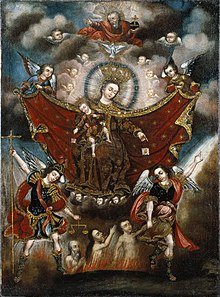Diego Quispe Tito

Circle of Diego Quispe Tito, 17th Century, Brooklyn Museum
Diego Quispe Tito (born 1611 in Cusco , Peru; died around 1681 there ) was a Quechua painter from Peru . He is regarded as one of the leading painters of the Cuzco School in Peruvian painting and as the most important indigenous painter of the South American colonial era.
life and work
Diego Quispe Tito was the son of an aristocratic upper class Inca family and was born in Cusco . He worked his entire life in the district of San Sebastián , where he died around 1681. His house still exists today and bears his family crest at the entrance.
The first known and signed picture by Quispe Tito is an Immaculate Conception from 1627, which was gilded in the typical style of the Cusco-Schulke . His work was done in the style of Spanish Mannerism and Flemish painting . Like other painters of the style, Quispe Tito was mainly influenced by Italian and Spanish Jesuits in the 16th and 17th centuries such as Juan Iñigo de Loyola , Bernardo Bitti , Pedro de Vargas , Mateo Pérez de Alesio and Angelino Medoro . It is also assumed that in his youth he had contact with Luis de Riaño , a painter from Lima and a student of Angelino Medoro, and that he took over from him some elements of his painting based on the model of older masters.
Quispe Tito was also influenced by copperplate engravings from Flanders . His best-known work, the Series del Zodiaco ( Signs of the Zodiac ) from 1681 in the Catedral Basílica de la Virgen de la Asunción , the Cathedral of Cusco, consists of a series of copies of Flemish engravings, in which each sign of the zodiac is accompanied by an episode from the life of Jesus Christ is connected. These engravings were made as mission pictures and distributed in Peru, where the worship of the sun, moon and stars was still practiced in the time of Quispe Tito, and were intended to encourage worship of Jesus Christ instead of the signs of the zodiac. Another series from 1663, which showed depictions of John the Baptist and which Quispe Tito painted for the Church of San Sebastián, was also based on Flemish engravings.
Quispe Tito also adds some personal elements to his pictures, especially the gilding that is typical for him and the depiction of landscapes populated with local birds such as parrots and angels. Some scholars regard the tropical parrots as a hidden symbol of resistance and potentially refer to the Inca nobility. In 1667 he painted several scenes from the life of Jesus Christ and sent them to Potosí . The date of his death is estimated to be 1681, since the painter's last known work is available from this year.
supporting documents
- ^ Leslie Bethell: The Cambridge History of Latin America , Cambridge University Press, 1995; P. 742. ISBN 0-521-24516-8 .
- ↑ a b c Diego Quispe Tito , presentation in the context of the project “Symbolic Representations and Social History” at the Latin America Institute of the Free University of Berlin; Retrieved May 25, 2015.
- ↑ a b c Cuzco School. Encyclopædia Britannica. Retrieved May 25, 2015.
Web links
- Diego Quispe Tito , presentation as part of the project “Symbolic Representations and Social History” at the Latin America Institute of the Free University of Berlin; Retrieved May 25, 2015.
| personal data | |
|---|---|
| SURNAME | Quispe Tito, Diego |
| BRIEF DESCRIPTION | Peruvian painter |
| DATE OF BIRTH | 1611 |
| PLACE OF BIRTH | Cusco , Peru |
| DATE OF DEATH | around 1681 |
| Place of death | Cusco , Peru |
